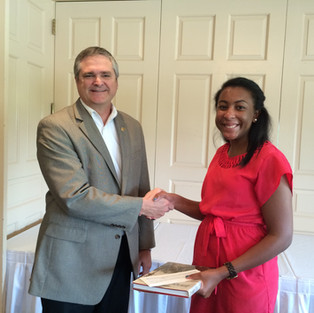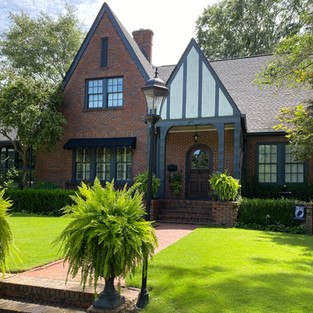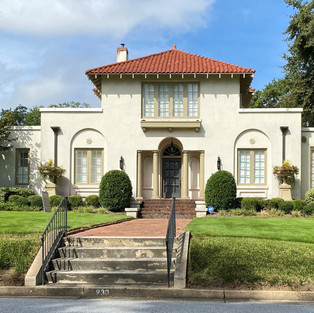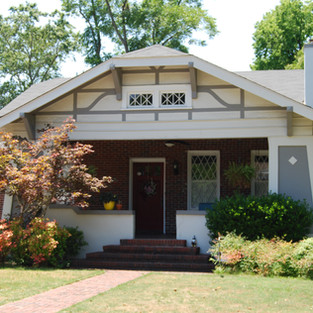
In 1964, the Springer was saved from the wrecking ball, and that was newsworthy. Fortunately, two early pioneers in the preservation movement, Clason Kyle and Mary Margaret Byrne, worked at the local paper. They kept it full of articles on local history and architecture, which kept the topic of preservation on the community’s mind. The time was right to organize, and Historic Columbus was born in 1966.

As with most things, timing is everything. One founder, Joan Davidson Mize Holder, was returning from a Junior League meeting in Savannah. On the flight to Columbus, she met Lee Adler, founder and President of the Historic Savannah Foundation. Knowing the new Columbus organization needed help, she talked him into meeting with them. Mr. Adler gave them direction, ideas for the legal structure, and the name of Historic Savannah’s consultant, Dr. Carl Feiss. Dr. Feiss was from Washington D. C., a Fellow of the American Institute of Architects, a noted architectural historian, and a city planner. He immediately initiated a survey of inventory of historic structures in Columbus, which ultimately consisted of over 400 properties.
When Feiss returned, he drew the lines for the Columbus Historic District, a twenty-six block area, south of Ninth Street, and west to Fourth Avenue (Veterans Parkway). This new district was one of Historic Columbus’ five initial nominations to the National Register of Historic Places. The National Register and the National Historic Preservation Act were established in 1966, the same year of the HCF inception. The National Register was the starting point. Historic buildings need to be listed on the Register if the new organization was going to protect them.

They had the list of the top priority properties and areas. Now, they needed to get local buy-in from City and community leaders. Two key individuals came on board – the City Manager, Franklin Lambert, and the Executive Director of the Housing Authority of Columbus, Brown Nicholson.

During this time, the Housing Authority of Columbus, Georgia was the City’s urban renewal agency. However, when you think urban renewal, horrible images of mowing down older neighborhoods come to mind. That didn’t happen in Columbus because of the foresight of Brown Nicholson. He made the decision to use the federal redevelopment funds to save the original city rather than destroy it. Preservation owes a tremendous debt to Brown and the Housing Authority.
By 1969, Janice Biggers volunteered to become the first Executive Director. With her in place, Historic Columbus purchased its first property and focused, like many other groups across the country, on developing a house museum. The first was the Walker-Peters-Langdon House, the oldest house in the city. Also that same year, Historic Columbus received $25,000 from the Junior League to create a Revolving-Redevelopment Fund. The purpose of the Fund would be to save endangered houses and put them back into sympathetic hands. Today, Historic Columbus has saved over 80 properties and brought over $13 million back onto the Muscogee County tax roles because of that initial investment.

Tourism was also going to be a key player in the success of preservation – as it had been a proven economic benefit in many other cities. Historic Columbus answered that call with bus tours and the development of Heritage Corner. Building on the attraction of the Walker-Peters-Langdon House, Historic Columbus would go on to restore four other houses to become a tourism hot spot. They included Dr. Pemberton’s townhome, an Italianate townhouse owned by a Supreme Court Justice of Georgia, a double pen farmhouse, and the oldest structure in Muscogee County, a log cabin. These five houses would tell the story of Columbus from 1800 – 1870.
The next phase in the process came in the form of downtown revitalization in 1980. Community leaders saw the positive economic impact of the historic district and looked next to the original business district. With Historic Columbus as an early partner at the beginning of Uptown Columbus, the losses of significant commercial buildings began to slow. The efforts for adaptive re-use began to gain momentum.

Heritage education also became an essential component of Historic Columbus’ mission through the organization’s second Executive Director, Patricia Jackson Howard. In addition to increasing school tours and programs, she created a book series called Our Town that would grow its impact within the school district over the next 25 years. By the early 1990s, Columbus had three historic districts (original city, Waverly Terrace, and High Uptown), one National Historic Landmark District (Industrial Riverfront), two National Historic Landmark properties (the Springer and the Folly), and about 100 individual properties listed on the National Register (commercial and residential). Historic Columbus had also saved many significant properties at this point – the Rankin House, the Depot, the Illges House, the Lion House, the two Woodruff houses on 2nd Avenue, and the Garrett-Bullock House, to name a few.

Historic Columbus hired its third Executive Director, Virginia Peebles, in 1992. She began to broaden the vision of what our community thought of as “historic.” During her tenure, the next wave for preservation came in the form of Columbus’ early suburbs. Historic Columbus’ footprint of impact grew considerably. Weracoba-St. Elmo, the first historic district in the suburbs of Wynnton, was listed on the National Register in 1994. This brought 400 more properties under local protection.

A new tool for revitalization was also developed by Historic Columbus and championed Brown Nicholson, now retired from the Housing Authority. Façade Loans enabled homeowners to paint their houses or install a new roof with money from Historic Columbus at no interest. This program was created in 1997 and became a definite winner. It continues to make a difference in historic neighborhoods. To date, over 250 loans have been made, representing almost $1.5 million in investment for older homes in Muscogee County.
In 2001, five other Wynnton neighborhoods and Columbus’ first African American neighborhood became historic districts. This brought the total of locally protected properties up to 2,500. The early 2000s was a period of great activity in the Wynnton area, from potential road improvement projects to community reinvestment. With Historic Columbus’ administration and coordination, a new organization was created to become the guardian of positive growth and community building in the larger Wynnton area. Midtown, Inc. was born in 2005.
The next chapter for Historic Columbus focuses on building onto the existing tools of neighborhood revitalization through expanding façade loan funding, enabling larger rehab loans to be made, stabilizing the last endangered National Historic Landmark, and providing large grants for bricks and mortar projects for buildings like churches and schools in desperate need of help. These efforts began with the celebration of HCF's 50th Anniversary in 2016 and have been successful because of your support of the Save Me A Place Capital Campaign.

(Above is a re-visioning of the City Mills area from the City Village Master Plan, 2015.)
Because of the generosity of the donors of the capital campaign, an investment of $1.2 Million was able to be made to stabilize the two mill buildings at City Mills. As a result of HCF's involvement and the continued investment of Ken Henson and Pezold Management, the revitalization of City Mills has served as a catalyst for further private development. If you have driven anywhere near the Rankin House lately, you have likely noticed a flurry of new construction in High Uptown. Adding up the estimated costs of these new projects under development, the total reaches nearly $90 million. These projects include – the Chase Homes redevelopment by the Columbus Housing Authority, a 70-unit new apartment complex by Ken Henson, Mercer School of Medicine, the Highside Market on 13th Street and 3rd Avenue, the Sputnik Bar, and City Mills, among others. These are exciting investments not only for High Uptown and City Village but also for the greater community. Thank you for believing in HCF and what historic preservation can do for the betterment of our community. As always, there's more to do! The future of preservation is bright and challenging. We hope you will join us on Tuesday, October 27th, at 5:30 PM for our virtual 54th Annual Meeting and Preservation Awards - there are some great projects you need to see!

Above: HCF Executive Directors Janice P. Biggers and Virginia T. Peebles Below: HCF Executive Directors Patricia J. Howard and Susan C. Lawhorne



Thank you for your support of Historic Columbus and for all YOU do for our community! We are grateful!

You have traveled with us to Monte Carlo and Singapore, but this year we must stay at home. While we will not be able to get together for a high roller evening at the tables, we hope you will consider turning your patron package or ticket into a donation for Historic Columbus. You can choose to designate your gift to the Patricia Jackson Howard Scholarship or the Virginia T. Peebles Preservation Grant.































Female Gurgaon Escorts offer professional and discreet services for clients seeking companionship in the city. These escorts are trained to provide a high level of satisfaction and are known for their elegance and charm. Whether you are looking for a social companion for an event or a more intimate encounter, these escorts are there to cater to your needs.